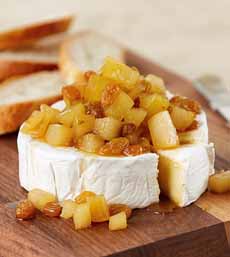TIP OF THE DAY: Brie For Dessert
|
Here’s an idea for Mother’s Day for moms who don’t want cake or other sugary dessert: Brie. Brie and its cheese brothers are known as bloomy-rind, soft-ripened or surface-ripened (i.e., ripened from the outside) cheeses. These terms refer to their their downy, edible white rind. The cheesemaker creates the rind by adding a powdered form of mold (Penicillium candidum, Penicillium camemberti), yeast, and/or a yeast-like fungus, Geotrichum candidum. These microorganisms bloom on the exterior of the ripening cheeses, ultimately forming the rind. They break down the fats and proteins of a cheese, creating the creamy texture. The result: lush, creamy, unctuous cheese delight. The longer the cheese ages, the runnier it gets. Cheese Trivia: An older cheese will develop an extra creamy, custardy layer just under the rind, which is called the creamline. It’s an extra layer of texture and flavor. Can you eat the bloomy rind? Any serious cheese lover will: It’s delicious! It’s easy to confuse Brie and Camembert. They are similar recipes, made in different parts of France with different terroirs. They are different sizes. Here’s the difference. Some other bloomy rind cheeses found in the U.S., both domestic and French, include: To bake or not to bake? In the warm weather, there’s no reason to bake a Brie—especially when it’s going to be sliced for individual portions. You can use all of these as a top garnish (photo #2), or serve some on the side (photo #1). Instead of baguette slices and water biscuits, go for flavorful choices such as: |
|
|
|
WHAT ABOUT SALAD? Some people enjoy a cheese course instead of a sweet dessert; and some like it with a bit of salad. Mesclun (mixed baby greens) with a light toss of vinaigrette is the way to go here. To avoid an acid clash with the sweet complements to the cheese, we make a balsamic vinaigrette. White wines and rosés pair better with bloomy rinds than red wines. Fruity whites are better than dry whites. We like a good Pinto Grigio or Sauvignon Blanc. Champagne or other dry sparkling wines (Cava, Crémant, Prosecco, etc.) add a festive flair, as do sweet sparklers such as Asti Spumanti, Brachetto d’Acqui (a rosé), or a dry Prosecco (in wine terminology, “dry” means sweeter). ________________ *Sweet herbs include chamomile, lavender, lemon verbena, licorice, mint, rose geranium and tarragon. |
||






